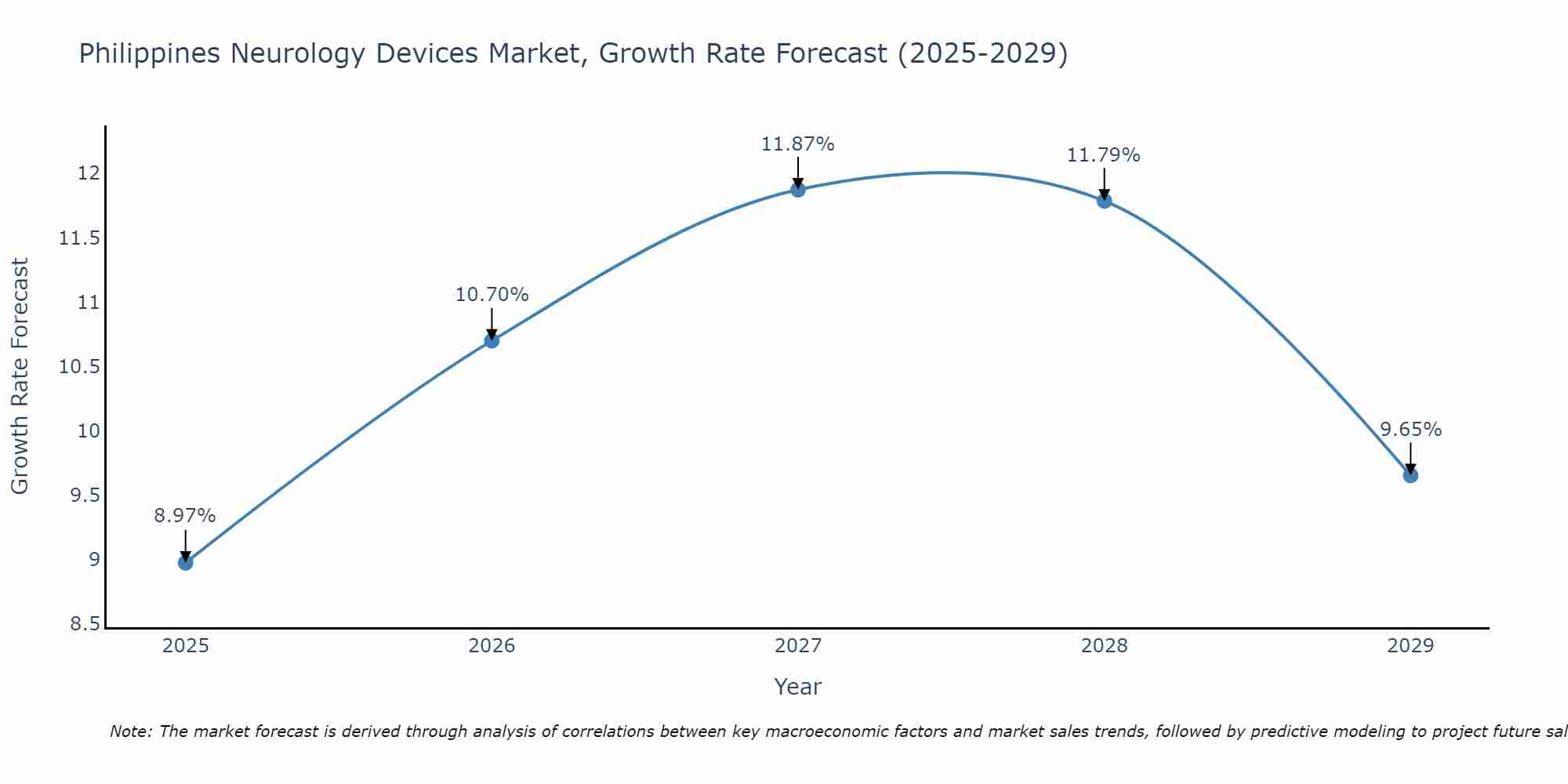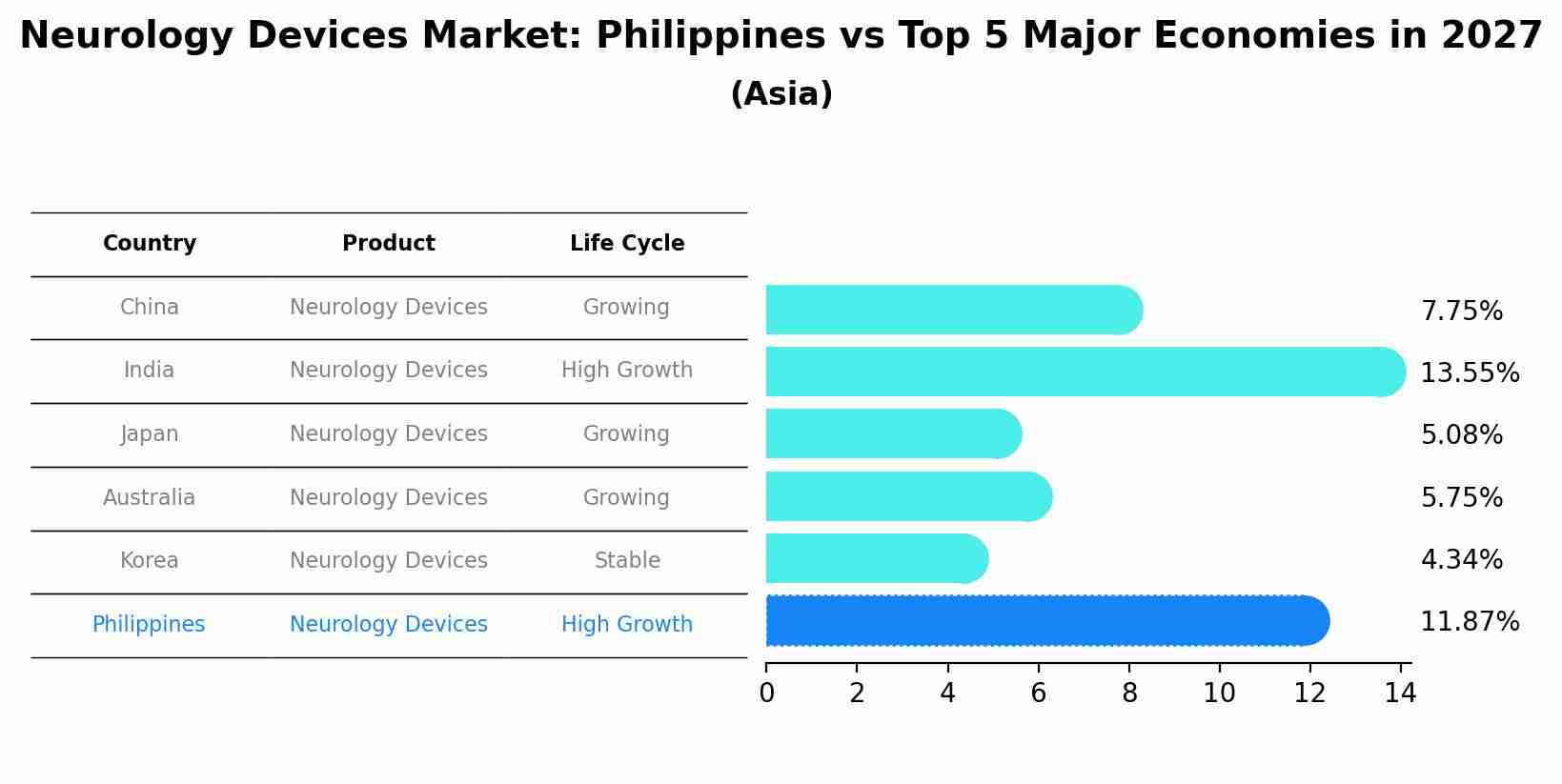Philippines Neurology Devices Market (2025-2031) Outlook | Size, Trends, Value, Forecast, Industry, Companies, Growth, Revenue, Analysis & Share
| Product Code: ETC367649 | Publication Date: Aug 2022 | Updated Date: Apr 2025 | Product Type: Market Research Report | |
| Publisher: 6Wresearch | No. of Pages: 75 | No. of Figures: 35 | No. of Tables: 20 | |
Philippines Neurology Devices Market Size Growth Rate
The Philippines Neurology Devices Market is projected to witness mixed growth rate patterns during 2025 to 2029. Growth accelerates to 11.87% in 2027, following an initial rate of 8.97%, before easing to 9.65% at the end of the period.

Neurology Devices Market: Philippines vs Top 5 Major Economies in 2027 (Asia)
Philippines's Neurology Devices market is anticipated to experience a high growth rate of 11.87% by 2027, reflecting trends observed in the largest economy China, followed by India, Japan, Australia and South Korea.

philippines neurology devices market Synopsis
The Philippines` neurology devices market has been witnessing growth due to an increasing prevalence of neurological disorders and a growing awareness of available treatments. The market includes devices for diagnostics, monitoring, and treatment of neurological conditions. The CAGR for this market could range from 5. 8% as healthcare infrastructure improves and neurological disorders receive more attention.
Drivers of the Market
The neurology devices market includes medical equipment used for diagnosing and treating neurological conditions. The outlook for this market in the Philippines could be influenced by advancements in healthcare technology, an aging population, and the prevalence of neurological disorders. The demand for improved diagnostic accuracy and treatment outcomes might drive the adoption of neurology devices.
Challenges of the Market
The neurology devices market in the Philippines might face challenges related to regulatory approvals and compliance with medical standards for safety and effectiveness. Ensuring accurate diagnoses and treatments, training medical professionals on device usage, and addressing data security and patient privacy concerns are critical challenges. Adapting devices to local healthcare infrastructure and managing costs could also be hurdles.
COVID-19 Impact on the Market
The COVID-19 pandemic might have influenced the neurology devices market in the Philippines. While the demand for neurology devices remains driven by medical needs, the focus of healthcare resources could have shifted towards pandemic-related priorities. This might have led to delays in non-urgent medical procedures, including those involving neurology devices. Telemedicine and remote patient monitoring could have gained importance as in-person consultations faced restrictions. The pandemic might have underscored the need for adaptable and resilient healthcare systems to address various medical specialties.
Key Players in the Market
Key players might include Medtronic, Abbott Laboratories, and Boston Scientific.
Key Highlights of the Report:
- Philippines Neurology Devices Market Outlook
- Market Size of Philippines Neurology Devices Market, 2024
- Forecast of Philippines Neurology Devices Market, 2031
- Historical Data and Forecast of Philippines Neurology Devices Revenues & Volume for the Period 2021-2031
- Philippines Neurology Devices Market Trend Evolution
- Philippines Neurology Devices Market Drivers and Challenges
- Philippines Neurology Devices Price Trends
- Philippines Neurology Devices Porter's Five Forces
- Philippines Neurology Devices Industry Life Cycle
- Historical Data and Forecast of Philippines Neurology Devices Market Revenues & Volume By Product for the Period 2021-2031
- Historical Data and Forecast of Philippines Neurology Devices Market Revenues & Volume By Neurostimulation Devices for the Period 2021-2031
- Historical Data and Forecast of Philippines Neurology Devices Market Revenues & Volume By Neurosurgery Devices for the Period 2021-2031
- Historical Data and Forecast of Philippines Neurology Devices Market Revenues & Volume By Interventional Neurology Devices for the Period 2021-2031
- Historical Data and Forecast of Philippines Neurology Devices Market Revenues & Volume By Cerebrospinal fluid management devices for the Period 2021-2031
- Historical Data and Forecast of Philippines Neurology Devices Market Revenues & Volume By Others for the Period 2021-2031
- Historical Data and Forecast of Philippines Neurology Devices Market Revenues & Volume By End User for the Period 2021-2031
- Historical Data and Forecast of Philippines Neurology Devices Market Revenues & Volume By Hospitals for the Period 2021-2031
- Historical Data and Forecast of Philippines Neurology Devices Market Revenues & Volume By Ambulatory surgery centers for the Period 2021-2031
- Historical Data and Forecast of Philippines Neurology Devices Market Revenues & Volume By Neurology clinics for the Period 2021-2031
- Philippines Neurology Devices Import Export Trade Statistics
- Market Opportunity Assessment By Product
- Market Opportunity Assessment By End User
- Philippines Neurology Devices Top Companies Market Share
- Philippines Neurology Devices Competitive Benchmarking By Technical and Operational Parameters
- Philippines Neurology Devices Company Profiles
- Philippines Neurology Devices Key Strategic Recommendations
Frequently Asked Questions About the Market Study (FAQs):
- Single User License$ 1,995
- Department License$ 2,400
- Site License$ 3,120
- Global License$ 3,795
Search
Related Reports
- Saudi Arabia Manlift Market (2025-2031) | Outlook, Size, Growth, Trends, Companies, Industry, Revenue, Value, Share, Forecast & Analysis
- Uganda Excavator, Crane, and Wheel Loaders Market (2025-2031) | Strategy, Consumer Insights, Analysis, Investment Trends, Opportunities, Growth, Size, Share, Industry, Revenue, Segments, Value, Segmentation, Supply, Forecast, Restraints, Outlook, Competition, Drivers, Trends, Demand, Pricing Analysis, Competitive, Strategic Insights, Companies, Challenges
- Rwanda Excavator, Crane, and Wheel Loaders Market (2025-2031) | Strategy, Consumer Insights, Analysis, Investment Trends, Opportunities, Growth, Size, Share, Industry, Revenue, Segments, Value, Segmentation, Supply, Forecast, Restraints, Outlook, Competition, Drivers, Trends, Demand, Pricing Analysis, Competitive, Strategic Insights, Companies, Challenges
- Kenya Excavator, Crane, and Wheel Loaders Market (2025-2031) | Strategy, Consumer Insights, Analysis, Investment Trends, Opportunities, Growth, Size, Share, Industry, Revenue, Segments, Value, Segmentation, Supply, Forecast, Restraints, Outlook, Competition, Drivers, Trends, Demand, Pricing Analysis, Competitive, Strategic Insights, Companies, Challenges
- Angola Excavator, Crane, and Wheel Loaders Market (2025-2031) | Strategy, Consumer Insights, Analysis, Investment Trends, Opportunities, Growth, Size, Share, Industry, Revenue, Segments, Value, Segmentation, Supply, Forecast, Restraints, Outlook, Competition, Drivers, Trends, Demand, Pricing Analysis, Competitive, Strategic Insights, Companies, Challenges
- Israel Intelligent Transport System Market (2025-2031) | Strategy, Consumer Insights, Analysis, Investment Trends, Opportunities, Growth, Size, Share, Industry, Revenue, Segments, Value, Segmentation, Supply, Forecast, Restraints, Outlook, Competition, Drivers, Trends, Demand, Pricing Analysis, Competitive, Strategic Insights, Companies, Challenges
- Uganda Precast and Aggregate Market (2025-2031) | Strategy, Consumer Insights, Analysis, Investment Trends, Opportunities, Growth, Size, Share, Industry, Revenue, Segments, Value, Segmentation, Supply, Forecast, Restraints, Outlook, Competition, Drivers, Trends, Demand, Pricing Analysis, Competitive, Strategic Insights, Companies, Challenges
- Australia IT Asset Disposal Market (2025-2031) | Strategy, Consumer Insights, Analysis, Investment Trends, Opportunities, Growth, Size, Share, Industry, Revenue, Segments, Value, Segmentation, Supply, Forecast, Restraints, Outlook, Competition, Drivers, Trends, Demand, Pricing Analysis, Competitive, Strategic Insights, Companies, Challenges
- UAE Building Thermal Insulation Market Outlook (2025-2031) | Revenue, Companies, Share, Trends, Growth, Size, Forecast, Industry, Analysis & Value
- Portugal Electronic Document Management Market (2025-2031) | Strategy, Consumer Insights, Analysis, Investment Trends, Opportunities, Growth, Size, Share, Industry, Revenue, Segments, Value, Segmentation, Supply, Forecast, Restraints, Outlook, Competition, Drivers, Trends, Demand, Pricing Analysis, Competitive, Strategic Insights, Companies, Challenges
Industry Events and Analyst Meet
Our Clients
Whitepaper
- Middle East & Africa Commercial Security Market Click here to view more.
- Middle East & Africa Fire Safety Systems & Equipment Market Click here to view more.
- GCC Drone Market Click here to view more.
- Middle East Lighting Fixture Market Click here to view more.
- GCC Physical & Perimeter Security Market Click here to view more.
6WResearch In News
- Doha a strategic location for EV manufacturing hub: IPA Qatar
- Demand for luxury TVs surging in the GCC, says Samsung
- Empowering Growth: The Thriving Journey of Bangladesh’s Cable Industry
- Demand for luxury TVs surging in the GCC, says Samsung
- Video call with a traditional healer? Once unthinkable, it’s now common in South Africa
- Intelligent Buildings To Smooth GCC’s Path To Net Zero













